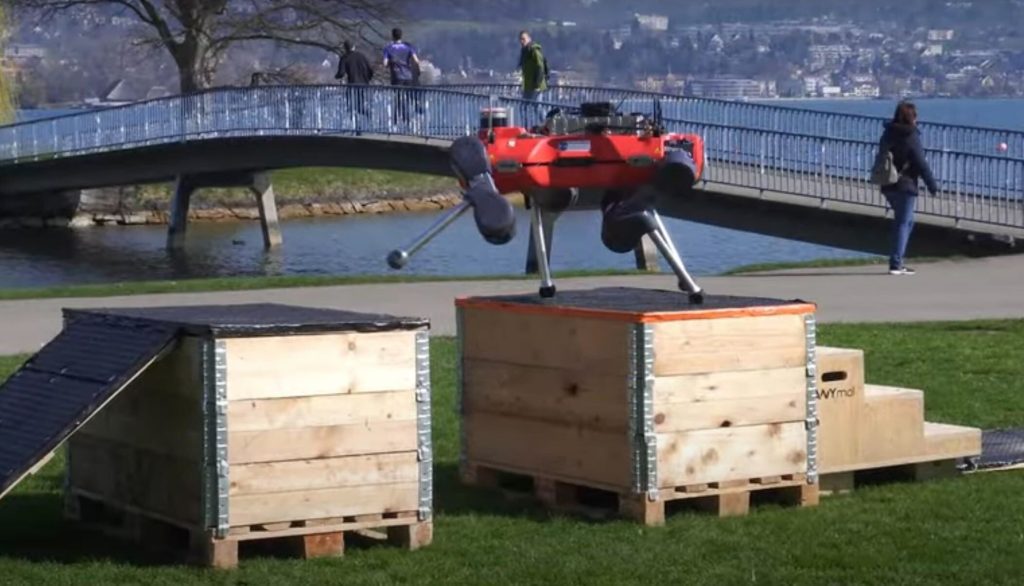Robots designed like dogs have shown they can do different tasks effectively, such as monitoring sports arenas from a distance and helping blind people get around to checking risky research locations. These robots are usually more agile than big bipedal robots, but so far, they haven't been as graceful and agile as real dogs. But now, a new climbing robot is changing what these four-legged robots can do, and it's doing it with style.
Researchers from ETH Zurich have created a new highly-mobile robot that can run, jump, and crawl through obstacle courses.
The researchers, who published their findings in the journal Science Robotics in this week, aimed to teach ANYmal, a 100-pound robot from ANYbotics by getting it to mimic human “freerunners” who do a sport called “parkour.” In simple terms, parkour is about moving as fast as possible from one place to another, often involving quickly crawling and jumping over obstacles. ANYmal was up to the challenge and was able to complete the basic parkour course at a speed of six feet per second.
How did ANYmal learn parkour?
A video of the newly trained ANYmal shows the sturdy red robot climbing a small wooden staircase, then jumping over a gap to another platform. It then quickly moves forward and ducks under an obstacle like an insect. ANYmal then climbs up a crate taller than its body and completes the course even when the obstacles are rearranged.
A video ANYmal uses onboard laser sensors to understand its surroundings and create maps to plan and follow a path without help. It has four lightweight carbon legs and 12 identical motors to move. The ETH researchers improved the robot's movement by using a neural network made of three parts for walking, sensing, and navigating.
In their paper, the researchers explain that they made ANYmal's navigation system understand how the robot walks, jumps, and crouches. With this knowledge, ANYmal can adjust its actions based on the obstacles it faces. The end result is a robot that can quickly recognize and handle a variety of obstacles and move through them.
Nikita Rudin, an ETH doctoral student working on ANYmal’s improvements, reportedly used his experience as a parkour enthusiast during the research.
them.
Rudin believed that legged robots still had untapped potential, despite what his colleagues thought before the project began.
recently told Science Daily . “In fact, I was sure that a lot more could be done with the mechanics of legged robots.”Researchers taught the model by using examples of human freerunners who complete parkour courses. ANYmal gained its new skills through trial and error in repeated simulations. Eventually, the robot was tested in a physical obstacles course, using the lessons it learned in simulation to complete the course.
“By aiming to match the agility of free runners, we can better understand the limitations of each component in the pipeline from perception to actuation, circumvent those limits, and generally increase the capabilities of our robots, which in return paves the road for many new applications, such as search and rescue in collapsed buildings or complex natural terrains,” the research said in a
Parkour inspiration could improve robots mean for search and rescue and space exploration statement
Unlike human freerunning, ANYmal’s new skills are intended for more than just looking cool. Looking to the future, researchers believe similar improvements could be applied to search and rescue robots to help them vault over obstacles or scurry into difficulty to reach areas during search and rescue missions. One day, the researchers note, these same type of advancements could possibly even aid in
space exploration robots traversing harsh, rocky surfaces of the moon and other planets. The added location could also apply to quadruped robots investigating hazardous areas of the Large Hadron Collider in Geneva, Switzerland. Those use cases are, for now, still largely hypothetical. In the meantime, ANYMal will join the likes of
Boston Dynamics’ Spot and Atlas robots on the ever growing list of metal machines uncannily performing athletic feats once reserved living beings. Researchers studied some very agile ‘freerunners’ to make this machine









